System Control Table
The following changes have been made to the System Control Table (SCT).
New Paste Option - Values, Flags, and Notes
When performing a copy and paste operation in a SCT, a new option is available: Paste Values, Flags, and Notes. As the name suggests, when it pastes the slot values, it will also paste the flags from the copied slot values rather than only pasting with the input (I) flag. This can be particularly helpful if flags like the maximum capacity (M) flag or target (T) flag were used on the source slots. Also, any series slot notes on the copied slot values will get pasted to the destination slot as well. (See Notes on Series Slots in User Interface for more information on series slot notes.) This new paste option is available from the Edit menu of the SCT or from the right-click shortcut menu of a selected series slot value in the SCT. See Copying and Pasting Slot Values in System Control Table (SCT) for more information.
Figure 1.29 SCT with Edit menu’s new Paste Values, Flags, and Notes option
fi

SCT Color Alerts
Color Alerts in the SCT allow for conditional formatting by changing the background or text color in cells based on slot values. The following enhancements were made to Color Alerts. See Configure Color Alerts in System Control Table (SCT) for more information.
Select an Alternative Reference Slot
Previously, the SCT allowed a slot’s cells to be conditionally colored based on the value in the slot at each timestep compared to specified Color Alert Thresholds. This functionality was enhanced to allow a slot’s cells to be conditionally colored based on the value in a different Reference Slot.
Figure 1.30 SCT Color Alerts with new Reference Slot

For example, in the above screenshot, Figure 1.30, the Color Alerts for Aspen.Outflow will be based on the values of the reference slot Aspen.Inflow.
A new column has been added to the Edit Series Slot List tab when the Configure Color Alerts option is selected to show the Reference Slot for any configured Color Alerts.
Condition Functions for Color Alerts
Previously, Color Alerts in the SCT were applied by checking whether the Reference Slot value fell within specified threshold intervals. A second option has been added: Condition Functions. This approach provides much greater flexibility for the conditional formatting by allowing you to define any logical condition.
With the Condition Functions option, you define global functions with a return type of Boolean. Then for each condition, you specify the function that defines that condition. The functions can use up to four arguments, one each of OBJECT, SLOT, NUMERIC, and DATETIME. The arguments are filled at the evaluation for each timestep based on the Reference Slot and its value at that timestep.
If multiple conditions are true, the Color Alert is applied based on the first condition that is true. The ordering of the conditions can be modified.
Figure 1.31 SCT Color alerts with new Functions condition type
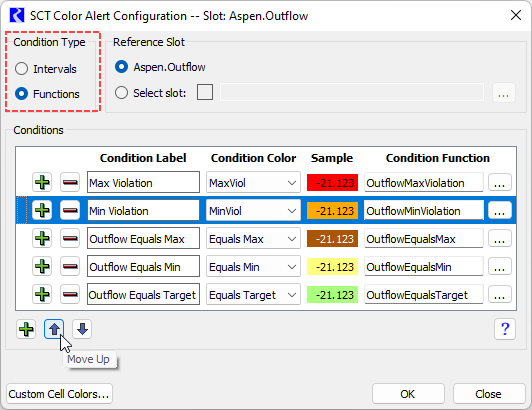
A new column has been added to the Edit Series Slot List tab when the Configure Color Alerts option is selected to show the function that is applied for each condition.
Figure 1.32 SCT Configure Color Alerts with new Function column
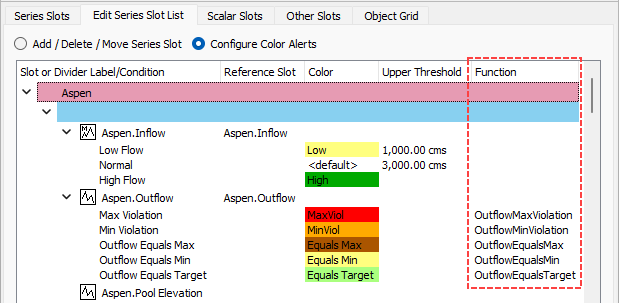
Series Slot Notes in the SCT
Multiple new operations have made it easier to add and edit series slot notes directly from the SCT without the need to open the Note Manager.
• See Display and edit series slot notes in System Control Table (SCT) for details on these new operations.
• See Notes on Series Slots in User Interface for more information on series slot notes and the Note Manager.
• See Adding and Editing Notes from Slots for similar enhancements for adding and editing series slot notes from the Slot Viewer.
Adding New Notes on Series Slots
Previously, to add new notes on series slots, it was necessary to first open the Note Manager and add notes from there. Now adding series slot notes is much easier with new options that quickly apply notes directly from the SCT without opening the Note Manager. Now by selecting one or more slot values and then right-clicking, the shortcut menu provides the following options from the Add Note menu.
• Create Note—opens the Create Note utility; you can type the desired note text, and select the Note Group to which you want to assign the note.
• Add Note in Group—allows you to select from notes already configured in the Note Manager, organized by Note Group.
Figure 1.33 SCT’s new context menu to Add Note
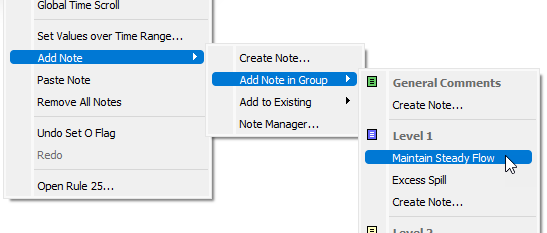
• Add to Existing—allows you to select from notes already configured in the Note Manager, but instead of applying the selected note directly, it opens the Create Note utility to allow you to add to or modify the selected note.
• Note Manager—opens the Note Manager window. From there you can add or edit notes and apply them to specified slots.
For any of the first three options, the note is immediately applied to the selected timesteps.
Editing Existing Notes on Series Slots
If you want to edit an existing note on a slot value from the SCT, a new option is available from the right-click shortcut menu after selecting the existing note: Replace with New Note. This opens the Create Note utility where you can modify the existing note text. The modified note replaces the note on the selected timesteps, and the modified note gets added to the Note Manager as a new note. Other instances of the old note remain unaffected.
Figure 1.34 SCT’s new options to create Notes directly from the SCT
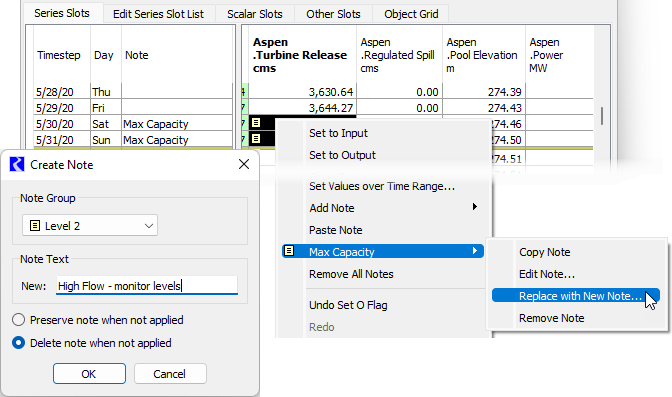
Removing Notes on Series Slots
A new right-click shortcut menu option for Remove All Notes has been added to quickly remove all series slot notes from the selected slot timesteps.
Note Icons in Aggregated View
Series slot timesteps display a note icon when there is a series slot note applied on that timestep. Previously the summary row in the aggregated view in the SCT did not display note icons. Now the summary row includes a note icon if one or more timesteps in the aggregation period have a note applied.
Figure 1.35 SCT showing the Notes icon in aggregated view
Snapshots in the SCT
The following enhancements have been made to the SCT to make it easier to manage snapshots and to view snapshot slots together with their corresponding source slots.
• See Snapshots for related enhancements to snapshots.
Snapshot Button Menu on the SCT
The Snapshot button has been added to the SCT toolbar so that operations related to snapshots can be accessed directly from the SCT. Selecting the Snapshot button presents a menu with the following options.
• Snapshot Manager - opens the Snapshot Manager. See Snapshot Manager in Output Utilities and Data Visualization for more information.
• Create Snapshot - creates a snapshot using the settings currently configured in the Snapshot Manager (see Creating and Viewing Snapshots in Output Utilities and Data Visualization).
• Apply Snapshot - pastes all values from the slots on the selected snapshot back into the source slots (see Apply Snapshot).
• Show Selected/Recent Snapshots - these options are described in the section Show Selected or Recent Snapshots in the SCT.
Figure 1.36 SCT options to create snapshots
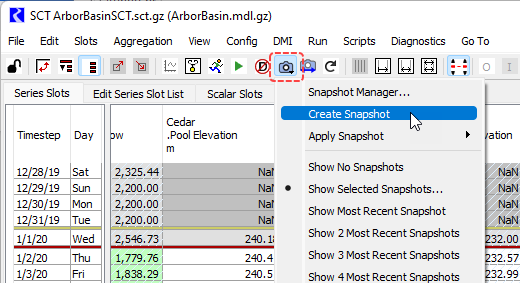
Show Selected or Recent Snapshots in the SCT
New options from the Snapshot button menu allow you to quickly view selected snapshot slots together with their source slots in the SCT. This makes it easier to compare results from runs preserved with snapshots. (Also see the related enhancements to plotting under Plotting Snapshot Slots.)
• Show No Snapshots - this is the default behavior. There is no automatic display of snapshot slots.
• Show Selected Snapshots - this option opens the Select Snapshots dialog where you can select which snapshots you want to display.
Figure 1.37 SCT options to select the snapshots for which slots will be shown

• Show N Most Recent Snapshots—this option will show slots from the most recent snapshots, where most recent is based on the timestamp from when the snapshot was created.
Figure 1.38 SCT options to show most recent snapshots
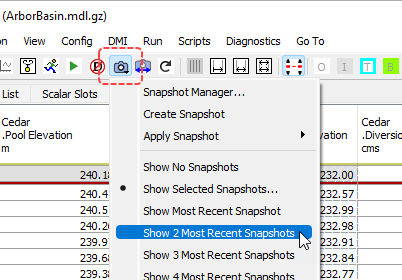
After making a selection, any slots in the selected snapshots that have a source slot in the SCT will be shown in the SCT. See Show recent snapshots in System Control Table (SCT) for more information.
Figure 1.39 SCT with resulting recent snapshot slots shown

A new column on the Edit Series Slot List tab allows you to control which slots in the SCT will have their corresponding snapshot slots displayed when one of the Show Selected/Recent Snapshots options is selected.
Figure 1.40 SCT Show Snapshot slots column in Edit Series Slot List tab
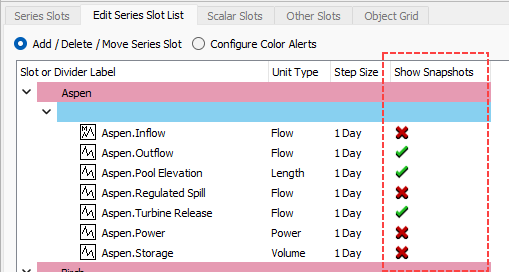
The new Show All Snapshot Slots button on the SCT toolbar can override the per slot setting of whether to show snapshot slots. When selected, all source slots in the SCT that are included in selected snapshots will have their corresponding snapshot slots displayed regardless of the per slot setting on the Edit Series Slot List tab. Selecting the button again will return to displaying snapshot slots based on the per slot settings.
Figure 1.41 SCT with Show All Snapshot Slots button

Revised: 01/05/2024